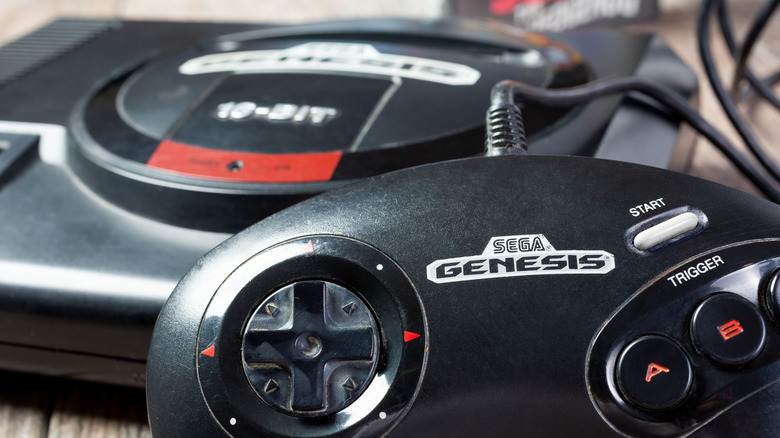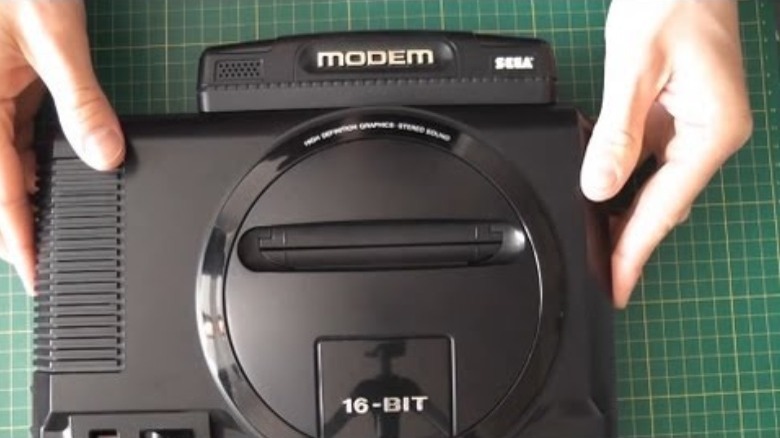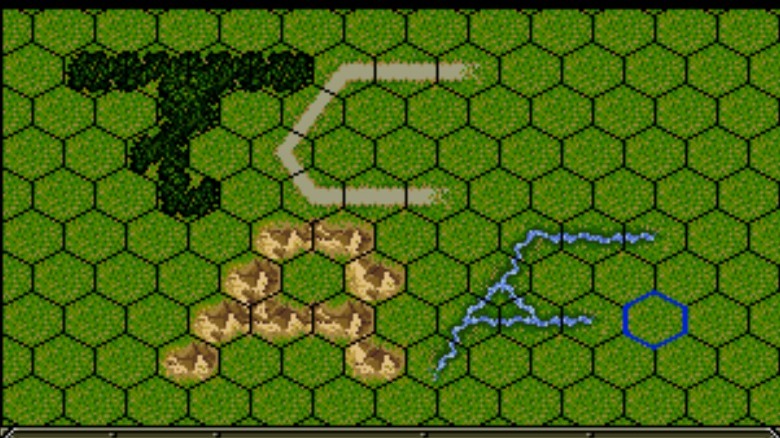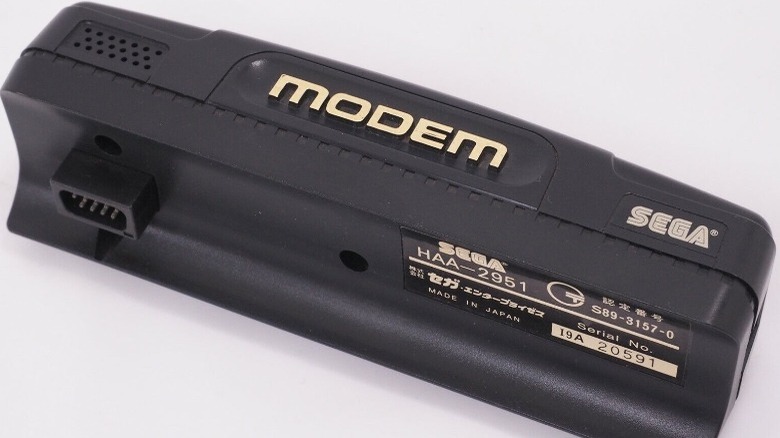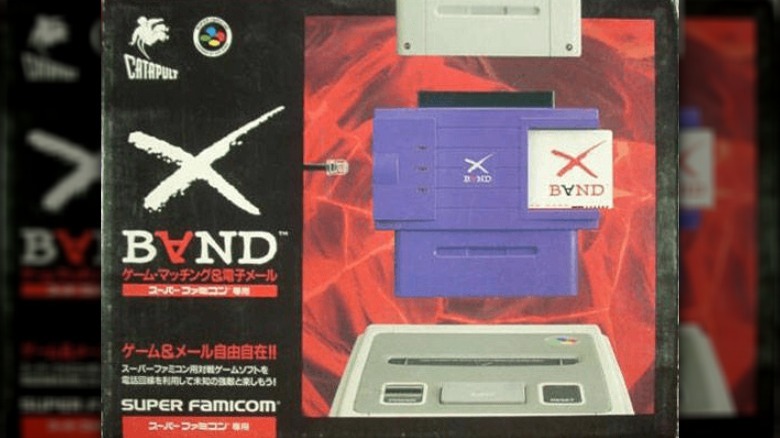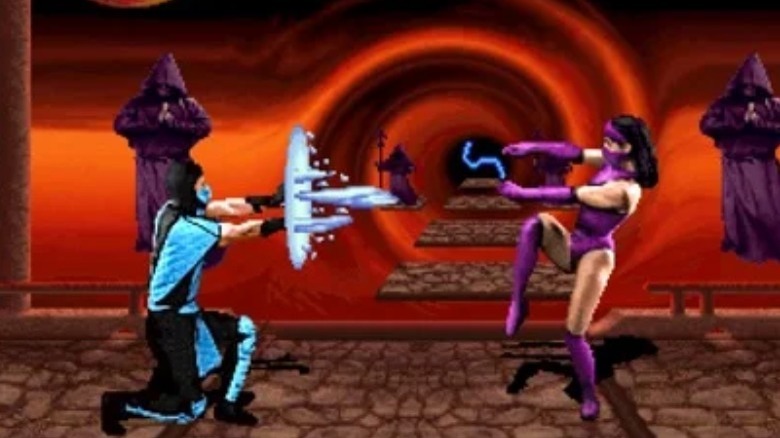The Interesting Story Behind Sega Genesis' Online Capabilities
Gamers who were around in the early '90s may remember the heated competition that took place between the Sega Genesis and Nintendo SNES. Nintendo was the reigning king of gaming at the time and Sega was seen as the young upstart company challenging Nintendo for the throne. To this end, Sega launched several aggressive ad campaigns aimed at convincing prospective buyers that it had the superior gaming system. These largely focused on technical specifications, such as the much-touted and little understood Blast Processing, but Sega and Nintendo also competed in another arena: attachable accessories.
The Genesis and SNES both had ports that allowed players to attach game-converters and other add-ons to the consoles. Sega and its partner companies released dozens of these (via Sega-16). The list included the Sega CD, the disastrous Sega 32x, the Mark 3 Adapter, the Team Player Multi-Tap, and the Mega CD Karaoke Unit. All added new functionalities that the Genesis didn't have on its own. One of the attachments even turned the Sega Genesis into the first gaming console to connect to the internet back in the early days of dial-up.
The first console on the internet
Sega released the Mega Modem in Japan in November 1990. This device plugged into the DE-9 port located on the back of the console, thereby making it the first console with the ability to access the World Wide Web. Keep in mind that this was back in the days when the internet was just getting started and only the simplest, text-based computer games had managed to make their way online (via Britannica).
According to Datapath.io, Sega's ability to connect the Genesis to the internet was made possible by the creation of IP Multicast in 1989. This allows users to communicate from one device to many or from many devices to even more. It's the same technology that was used by service providers to give home users easy access to the internet.
Sega launched its Meganet online gaming service the very next year alongside the Mega Modem. Sega itself was the internet service provider for these modems, and it was clear from the beginning that the technology had some rough patches. The connection speed was incredibly slow, only offering a transmission speed of 1200bps. This meant that the actual online gaming capabilities were limited, but it was still something completely unique in its time (per Sega-16).
Not many games
Only 13 of the game and software cartridges released for the Genesis made use of the network capabilities of the original Mega Modem. One of the most notable titles was the turn-based strategy title "Advanced Daisenryaku: Deutsch Dengeki Sakusen," which allowed players to control a battlefield composed of hexagonal grids by strategically moving tanks and other units. There was also the futuristic football title "Cyberball," which was originally developed for a launch in the states but was later given Mega Modem support for its Japan release, and a baseball game called "Tel-Tel Stadium" where users could only control the pitcher and batter in an otherwise automated game.
There were also a few simple titles that let gamers play online table-top entries like Go, Mahjong, and simple puzzles. Another cartridge, "Nikkan Sports Pro Yakyuu VAN," let those with a VAN subscription to watch sports in real-time. Then there was the really weird stuff, like a handful of rare software cartridges that allowed people to manage things like banking and life insurance using their Mega Modem. More powerful games made it to the console later, however, as modem technology improved.
The Mega Modem was supposed to come to the U.S.
According to an article from the UK magazine New Computer Express (p. 4), a variation of the Mega Modem was originally intended for distribution in the U.S. where it would be rebranded as the TeleGenesis Modem. It was set for release with the game "TeleGenesis Baseball" at launch and had "agreements from 20 leading American software houses, including Activision and Spectrum Holobyte, to supply games for the Genesis" that would take advantage of this technology.
A later issue of the magazine (p. 4) stated that the device would also be used in conjunction with the Sega CD and Mega Video in order to offer sing-along CDs. Users who had these devices would be able to use the modem to download new songs and expand their library. It seemed to be a major part of the initial marketing for the Genesis. None of this came to pass, however.
Ken Horowitz of Sega-16 argued that this was because "Sega's bold decision for long distance gaming (LDG) didn't just run into some trouble; it smashed head-first into a solid brick wall ... Back in the 1980s, this was unknown territory, and most thought that the prospect of LDG was years off, at best." It seems the endeavor of developing a nation-wide gaming internet service for the U.S. proved to be too monumental a task for Sega.
Different variations arose over time
There were two different models of the original Japanese Mega Modem and each of them had their own method of connecting to the internet. One had an outlet where a user could attach a normal phone line while the other had a built-in RS232C cable. Other than that, their specs were identical. This was the first modem attachment for the Sega Genesis, but it wouldn't be the last. The two bigger examples that followed were the Catapult X-Band and the Sega Channel Cartridge – both of which didn't come out until 1994.
The X-Band released for both the Genesis and the SNES and was later made available for the Sega Saturn. It had a $4.95 per month subscription service, doubled the transmission speed to 2400bps, and was the first device to fully support online play. The Sega Channel was slightly different. It wasn't strictly an internet connectivity device, but rather generated a method of streaming content to the Genesis using cable television. A $13 monthly subscription would grant users access to a catalog of video games. It was similar to how things like Xbox Game Pass or PS Plus memberships work today. Users could also access gaming tips, news, and special previews of upcoming releases.
Another internet connection tool called the Mega-Net Modem later launched in Brazil in conjunction with the company Tec Toy. This allowed users to surf the internet, email, and fax. Only a few came out, however, and the network was quickly disbanded (per Sega-16).
More powerful modems meant more powerful games
While the release of the X-Band on the SNES meant that the Sega Genesis was no longer the only console with access to the internet, it also marked the beginning of true online gaming. Major titles like "Madden NFL '95," "NBA Jam," "Primal Rage," "Super Street Fighter 2: The New Challengers," and the three original "Mortal Kombat" games all received online capabilities through the device. According to Video Game Kraken, Catapult eliminated the lag associated with the low speeds by customizing "the modem to reduce the transmission delays from 1/5 of a second to 1/30 of a second." This opened up a brand new world of competitive gaming at a time when arcades and couch multiplayer were still the norm.
The X-Band first released in Japan, but online gaming finally came to the West in June 1995. It was sold in several popular brick-and-mortar storefronts such as Blockbuster Video and Funcoland. Like the Sega Channel, it also operated on a monthly subscription service. There was an unlimited plan that was $7.95 per month and a cheaper $4.95 per month subscription service that allowed users to connect to the internet up to 50 times with an additional $0.15 charge per use. Online gaming has grown in popularity with each successive generation of console, but this is where it all began.

